Characteristics and Sources of Air Pollution in Southern Shanxi Province
Abstract
:1. Introduction
2. Data and Methods
2.1. Data Sources
2.2. Methodology
2.2.1. HYSPLIT_4 Model, PSCF and CWT
2.2.2. Calculation Method of AQI
3. Results and Discussion
3.1. Analysis of Air Pollution Characteristics in Jincheng
3.2. Analysis of Conveying Path
3.3. Analysis of Pollution Source Area
3.4. Discussion
4. Conclusions
Author Contributions
Funding
Institutional Review Board Statement
Data Availability Statement
Acknowledgments
Conflicts of Interest
References
- Wang, G.C.; Wang, D.Q.; Chen, Z.L. Characteristics and transportation pathways and potential sources of a severe PM2.5 episodes during winter in Beijing. China Environ. Sci. 2016, 36, 1931–1937. [Google Scholar]
- Lv, X.; Guo, Q.B.; Jiang, C.L. Straw incineration monitoring and air pollution effect analysis in the three eastern provinces in the autumn of 2015–2017. Environ. Pollut. Prev. 2021, 43, 611–613, 663. [Google Scholar]
- Deng, X.J.; Huang, J.; Wu, D. Analyses on the typical atmospheric pollution processes in Shenzhen area. China Environ. Sci. 2006, 26, 7–11. [Google Scholar]
- Yan, C.X.; Zhou, X.; Zhang, H.M. Mingjun Study on temporal and spatial variation characteristics and influencing factors of ambient air pollution in Nanchang. Resour. Environ. Yangtze River Basin 2019, 28, 1446–1459. [Google Scholar]
- Xu, X.D.; Zhou, L.; Zhou, X.J. Influencing domain of peripheral sources in the urban heavy pollution process of Beijing. Sci. China Ser. D Earth Sci. 2005, 48, 565–575. [Google Scholar] [CrossRef]
- Ye, X.; He, T.; Xia, J. Analysis of a simultaneous pollution process of atypical particulate matter and ozone. Environ. Prot. Technol. 2017, 23, 7–14. [Google Scholar]
- Draxler, R.R.; Hess, G.D. Description of the HYSPLIT_4 Modeling System; NOAA Technical Memorandum ERL ARL-224; NOAA Air Resources Laboratory: Silver Spring, MA, USA, 1997.
- Draxler, R.R.; Hess, G.D. An overview of the HYSPLIT_4 modelling system for trajectories, dispersion, and deposition. Aust. Meteorol. Mag. 1998, 47, 295–308. [Google Scholar]
- Draxler, R.R. HYSPLIT_4 User’s Guide; US Department of Commerce, National Oceanic and Atmospheric Administration, Environmental Research Laboratories, Air Resources Laboratory: Silver Spring, MA, USA, 1999.
- Park, J.; Ryu, J.; Kim, D. Long-range transport of S02 from continental Asia to northeast Asia and the northwest Pacific Ocean: Flow rale estimation using OMI data surface insitudata, and the HYSPLIT model. Atmosphere 2016, 7, 53. [Google Scholar] [CrossRef] [Green Version]
- Anil, I.; Karaca, F.; Alagha, O. Investigation of long-range atmospheric transport effects on Istanbul “Inhalable particulate matter episodes”. Ekoloji 2009, 19, 86–97. [Google Scholar] [CrossRef]
- Fishman, J.; Balok, A.E. Calculation of daily tropospheric ozone residuals using TOMS and empirically improved SBUV measurements: Application to an ozone pollution episode over the eastern United States. J. Geophys. Res. Atmos. 1999, 104, 30319–30340. [Google Scholar] [CrossRef]
- Chen, L.; Zhang, L.; Zhang, L. Characteristics of black carbon aerosol and carbonaceous gases and their emission sources in semi-arid region. China Environ. Sci. 2012, 32, 1345–1352. [Google Scholar]
- Yang, Y.; Li, X.R.; Chen, X. Analysis of different particle sizes, pollution characteristics, and sources of atmospheric aerosols during the spring dust period in Beijing. Environ. Sci. 2018, 39, 5315–5322. [Google Scholar]
- Shi, G.E.; Yao, Y.Q.; Zhang, P. Transport trajectory classifying of PM10 in Hefei. Plateau Meteorol. 2008, 27, 1383–1391. [Google Scholar]
- Zhao, H.; Wang, T.J.; Jiang, F. Investigation into the source of air pollutants to Hong Kong by using backward trajectory method during the Trace-P campaign. J. Trop. Meteorol. 2009, 25, 181–186. [Google Scholar]
- Zhan, M.J.; Sun, J.Y.; Zhang, Y.M. The influence of air mass sources on the particle number concentration and the size distribution at Mt. Waliguan. J. Glaciol. Geocryol. 2009, 31, 659–663. [Google Scholar]
- Gao, J.H.; Zhu, B.; Wang, D.D. The variation of air pollutants and the impact of long-range transport in the northern suburb of Nanjing. Acta Sci. Circumslantiae 2012, 32, 1149–1159. [Google Scholar]
- Bao, M.Y.; Cao, F.; Liu, S.D.; Liu, X.Y.; Zhang, Y.Y.; Zhang, W.Q.; Tang, T.R.; Gao, Y.Q.; Zhang, Y.L. Study on evolution characteristics and influencing factors of main air pollutants in Suzhou suburbs. J. Ecol. Environ. 2017, 26, 119–128. [Google Scholar]
- Fu, C.B.; Dan, L.; Tong, J.H. Characteristics and cause analysis of a continuous air pollution process in Haikou in autumn 2017. Environ. Chem. 2021, 40, 1048–1058. [Google Scholar]
- Li, L.L.; Zhu, L.N.; Yan, Y.Z. Jiang Junqiu Analysis of primary air pollution process and potential source area in Suihua City. J. Environ. Sci. 2020, 40, 3785–3793. [Google Scholar]
- Li, Y.Y.; Yang, H.R.; Wang, N. Yao Jialin Cause analysis of a heavy pollution weather process in Taiyuan. J. Meteorol. Environ. 2018, 34, 11–18. [Google Scholar]
- Yang, X.C.; Du, M.M.; Wu, Q.Z. Analysis on meteorological condition and trajectory of a serious pollution weather in Xi’an of Shaanxi. J. Arid. Meteorol. 2016, 34, 547–552. [Google Scholar]
- Liu, N.; Yu, Y.; He, J.J.; Zhao, S. Analysis of air pollutant transport in winter in Lanzhou. Res. Environ. Sci. 2015, 28, 509–516. [Google Scholar]
- Liang, D.; Wang, B.; Wang, Y.Q.; Zhang, H. Distribution characteristics and sources of PM2.5 and gaseous pollutants in winter in Chongqing. Res. Environ. Sci. 2015, 28, 1039–1046. [Google Scholar]
- Zhao, Y.; Hu, G.R.; Yu, R.L. Concentrations and spatial-temporal characteristics and source analysis of PM2.5 in Nanchang City in 2013. Res. Environ. Sci. 2017, 30, 854–863. [Google Scholar]
- Zhou, M.; Qiao, L.P.; Zhu, S.H. Chemical characteristics of particulate matters and trajectory influence on air quality in Shanghai during the heavy haze episode in December, 2013. Environ. Sci. 2016, 37, 1179–1187. [Google Scholar]
- Duan, S.G.; Jiang, N.; Yang, L.M. Transport pathways and potential sources of PM2.5 during the winter in Zhengzhou. Environ. Sci. 2019, 40, 86–93. [Google Scholar]
- Wojcik, G.S.; Chang, J.S. A re-evaluation of sulfur budgets, lifetimes, and scavenging ratios for eastern North America. J. Atmos. Chem. 1997, 26, 109–145. [Google Scholar] [CrossRef]
- Wang, L.; Xu, C.L.; Xu, F.; Gao, Q. Temporal and spatial distribution characteristics and potential source analysis of original aerosol optical thickness in Beiping, China from 2011 to 2020. J. Earth Sci. Environ. 2021, 43, 1018–1032. [Google Scholar]
- Song, Y.F.; Huang, J.; Luo, D.T. Analysis on potential sources of atmospheric particulate matter in Hengyang City from 2019 to 2020. J. Xiangtan Univ. (Nat. Sci. Ed.) 2021, 43, 100–112. [Google Scholar]
- Cheng, Y.N.; Liu, D.W.; Wang, J. Simulation and characteristic analysis of air pollution process in Hohhot based on WRF Chem mode. J. Inn. Mong. Univ. (Nat. Sci. Ed.) 2021, 52, 371–380. [Google Scholar]
- Begum, B.A.; Kim, E.; Jeong, C.H. Evaluation of the potential source contribution function using the 2002 Quebec forest fire episode. Atmos. Environ. 2005, 395, 3719–3724. [Google Scholar] [CrossRef]
- Hsu, Y.K.; Holsen, T.M.; Hopke, P.K. Comparison of hybrid receptor models to locate PCB sources in Chicago. Atmos. Environ. 2003, 37, 545–562. [Google Scholar] [CrossRef]
- Wang, S.; Liao, T.T.; Wang, L.L. Atmospheric characteristics of a serious haze episode in Xi’an and the influence of meteorological conditions. Acta Sci. Circumslantiae 2015, 35, 3452–3462. [Google Scholar]
- Phuong, D.T.K.; Nhut, M.C.; Tri, N.D. Research on air pollution assessment in Ho Chi Minh City, Vietnam, 2015–2019 based on RS and GIS, earth and Environmental. Sciences 2018, 32, 1–6. [Google Scholar]
- Zhang, X.G.; Jimmy, C.H.; Zhang, Y.M. China 2020 PM2.5 Emission assessment: Impact of comprehensive emission reduction policies environmental pollution. China Environ. Sci. 2020, 263–293. [Google Scholar]
- Sharma, R.; Kumar, R.; Singh, P.K. A Systematic Study on the Analysis of the Emission of CO, CO2 and HC for Four-Wheelers and Its Impact on the Sustainable Ecosystem. Sustainability 2020, 12, 6707. [Google Scholar] [CrossRef]
- Yan, S.M.; Wang, Y.; Guo, W.; Li, Y. Study on air pollution characteristics, transportation, ways and potential pollution sources in autumn and winter in Taiyuan. Huanjing Discip. Environ. Sci. 2019, 40, 150–159. [Google Scholar]
- Wang, S.Q.; Li, W.B.; Deng, X.J. Characteristics of air pollutant transport channels in Guangzhou. China Environ. Sci. 2015, 35, 2883–2890. [Google Scholar]
- Pan, Y.Y.; Chen, D.H.; Ye, S.Q. Characteristics and influencing factors of typical cases of air pollution in Guangdong Province. Saf. Environ. Eng. 2017, 24, 58–66. [Google Scholar]
- Ren, C.B.; Wu, L.X.; Zhang, Y.Y. Analyze to the seasonal differences of transport pathways and potential source-zones of Beijing Urban PM2.5. China Environ. Sci. 2016, 36, 2591–2598. [Google Scholar]
- Wang, Y.Q.; Zhang, X.Y.; Draxler, R. TrajStat: GIS-based software that uses various trajectory statistical analysis methods to identify potential sources from long-term air pollution measurement data. Environ. Model. Softw. 2009, 24, 938–939. [Google Scholar] [CrossRef]
- Xiao, Y.; Tian, Y.Z.; Xu, W.X. Study on the spatiotemporal characteristics and socioeconomic driving factors of air pollution in China. Ecol. Environ. Sci. 2018, 27, 518–526. [Google Scholar]
- Xin, A.X.; He, C.; Peng, Y.X. Hong Song Temporal and spatial distribution and regional transmission contribution of air pollutants in Wuhan. Environ. Sci. Technol. 2020, 43, 170–181. [Google Scholar]
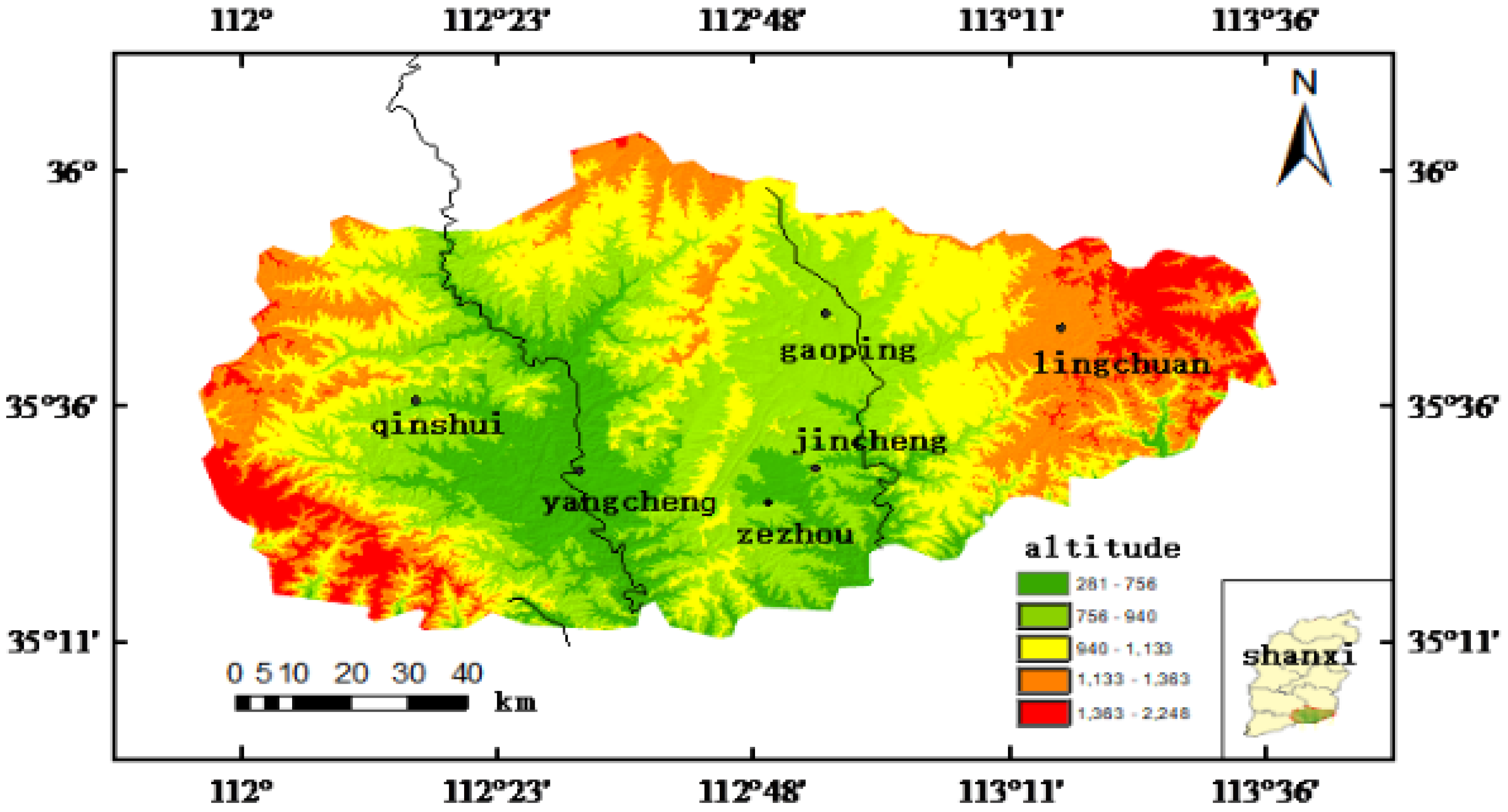


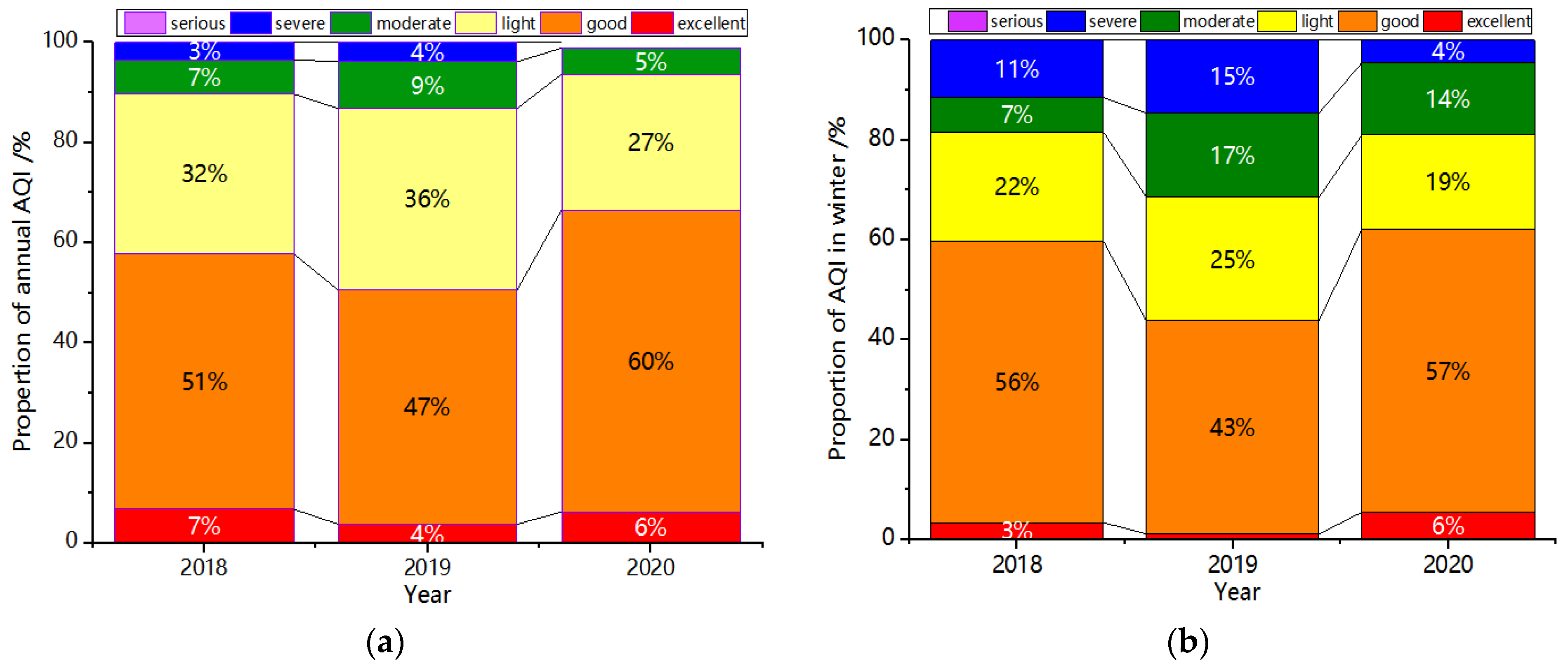
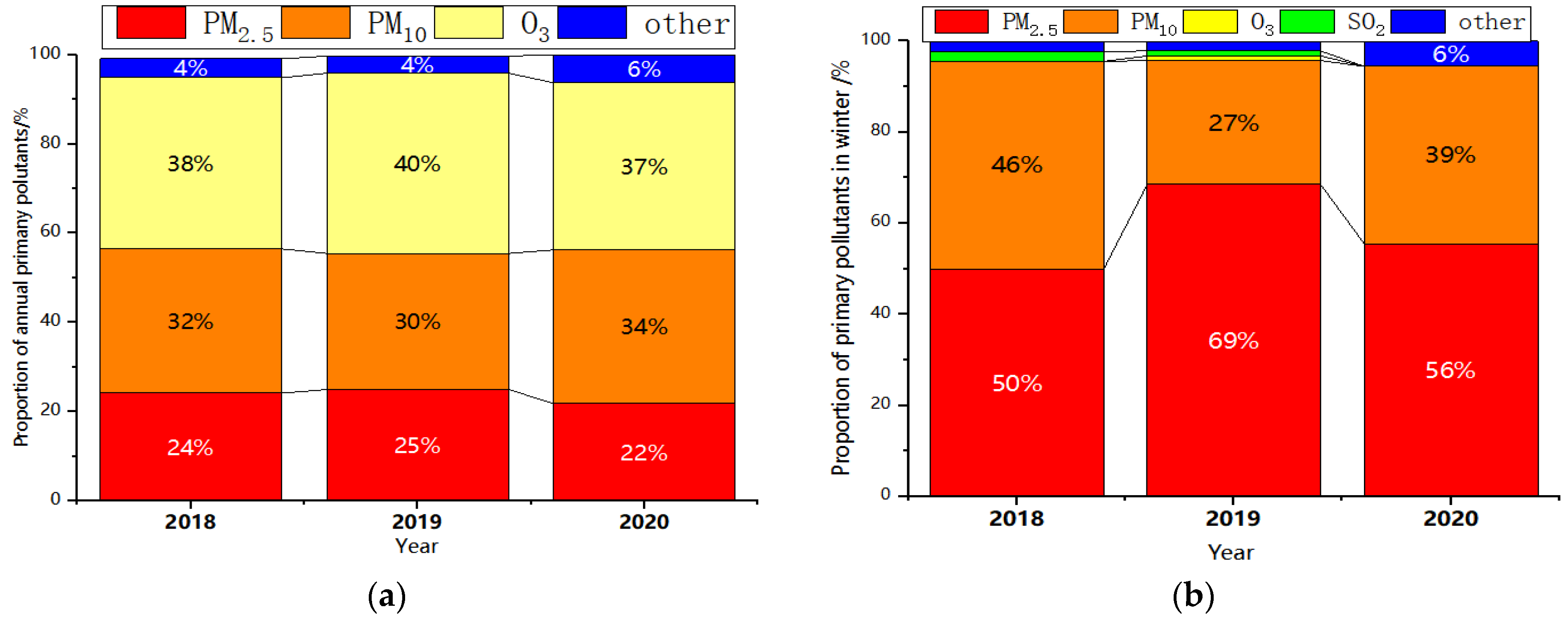
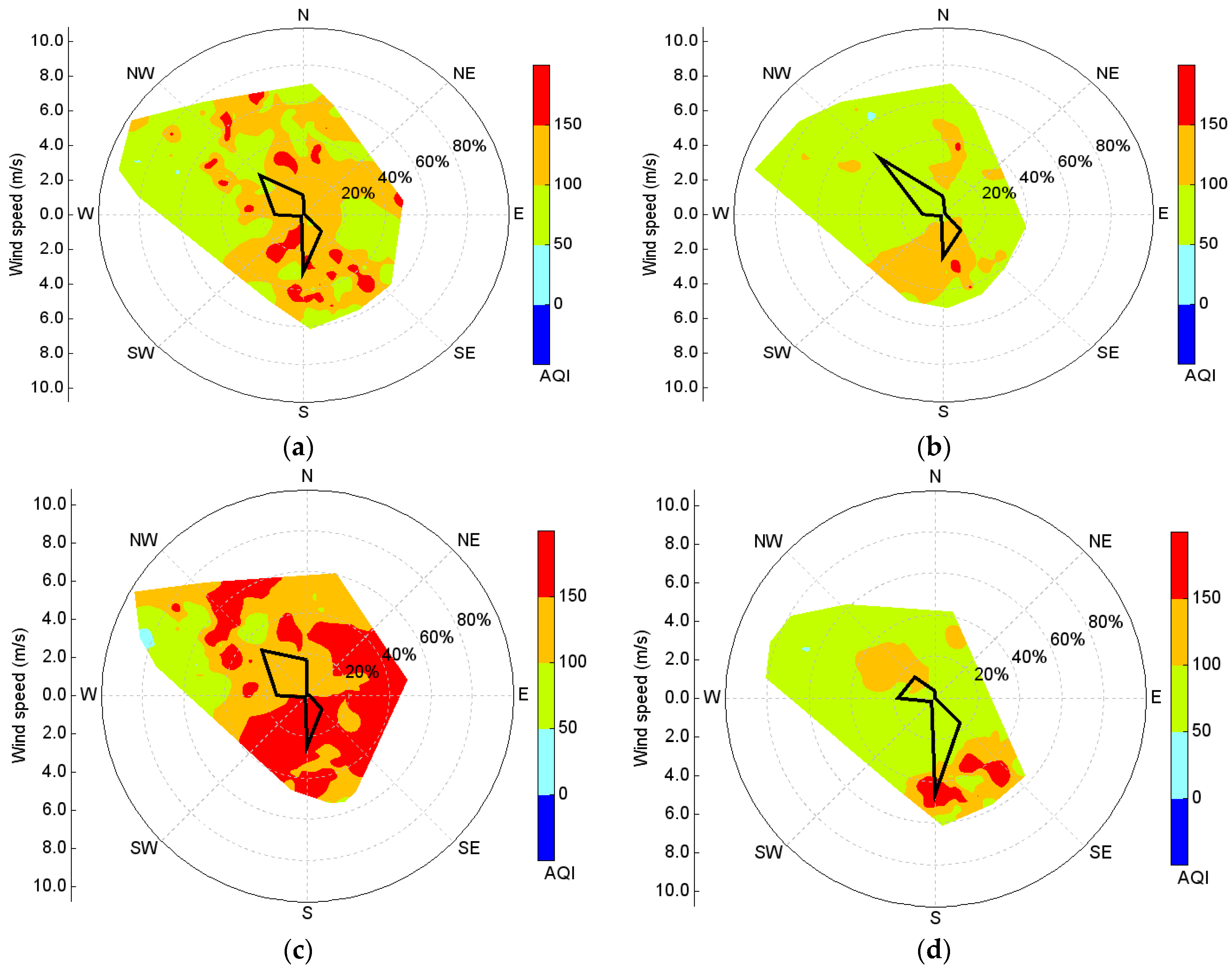
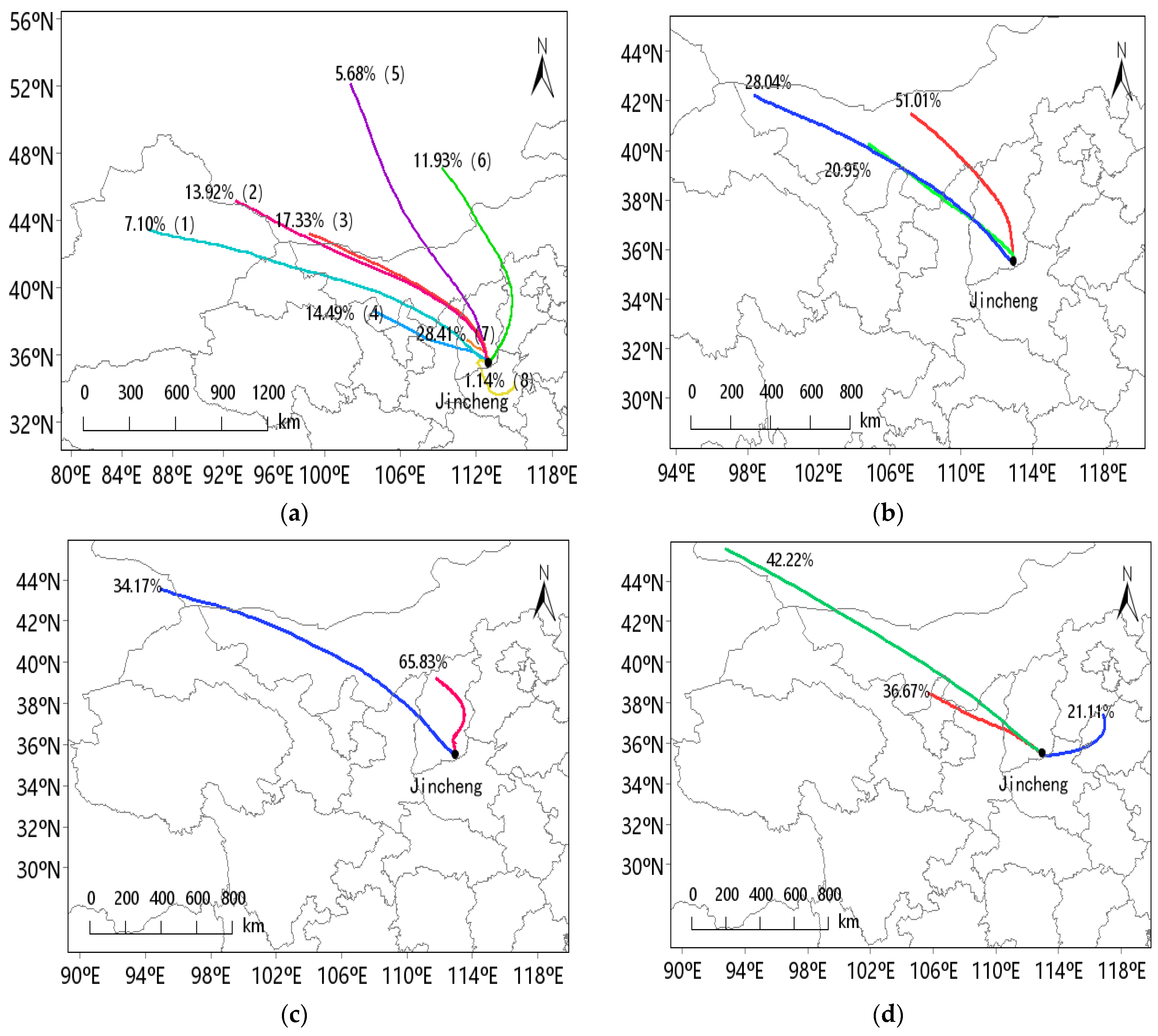
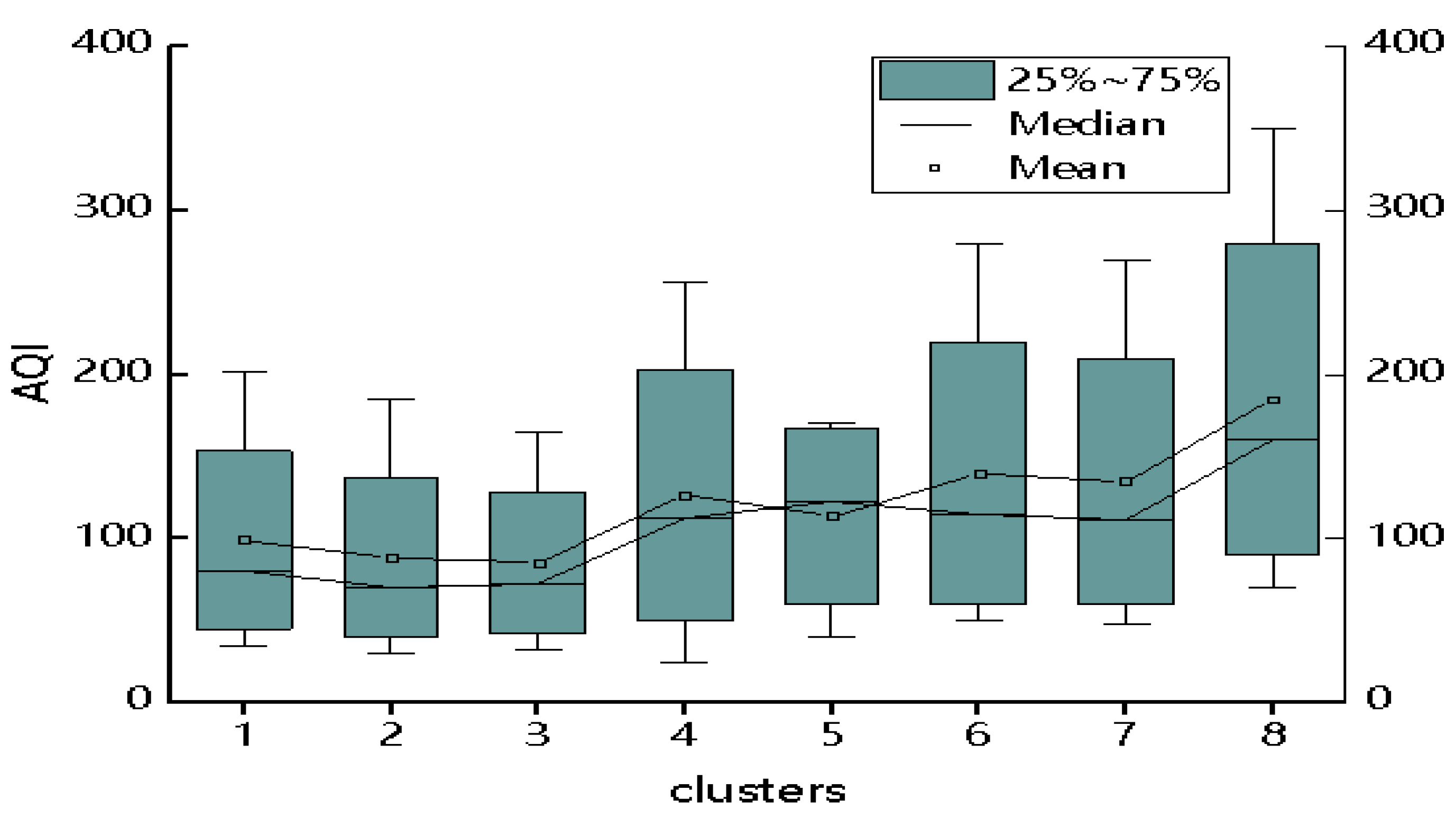
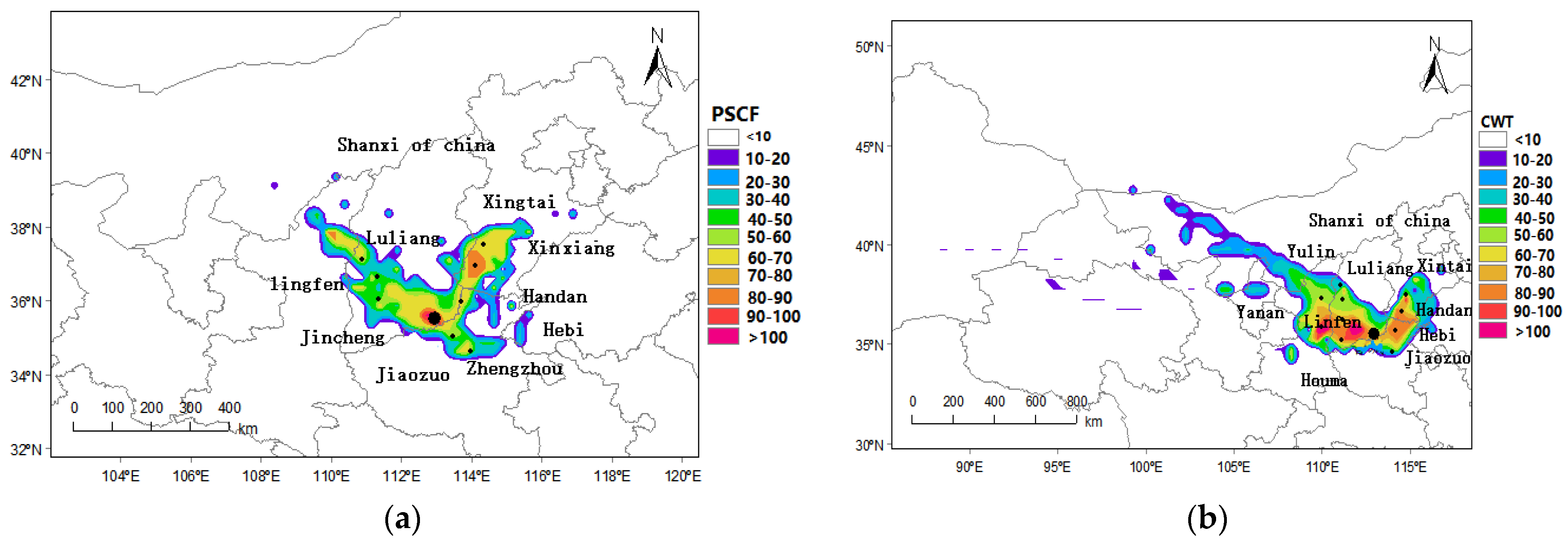
| Air Quality Sub-Index (I) | Pollutant Project Concentration Limits | |||||||||
|---|---|---|---|---|---|---|---|---|---|---|
| SO2 | SO2 | NO2 | NO2 | PM10 | CO | CO | O3 | O3 | PM2.5 | |
| 24 h Avg | 1 h Avg | 24 h Avg | 1 h Avg | 24 h Avg | 24 h Avg | 1 h Avg | 1 h Avg | 8 h Avg | 24 h Avg | |
| 0 | 5 | 0 | 0 | 0 | 0 | 0 | 0 | 0 | 0 | 0 |
| 50 | 50 | 150 | 40 | 100 | 50 | 2 | 5 | 160 | 100 | 35 |
| 100 | 150 | 500 | 80 | 200 | 150 | 4 | 10 | 200 | 160 | 75 |
| 150 | 475 | 650 | 180 | 700 | 250 | 14 | 35 | 300 | 215 | 115 |
| 200 | 800 | 800 | 280 | 1200 | 350 | 24 | 60 | 400 | 265 | 150 |
| 300 | 1600 | 565 | 2340 | 420 | 36 | 90 | 800 | 800 | 250 | |
| 400 | 2100 | 750 | 3090 | 500 | 48 | 120 | 1000 | 350 | ||
| 500 | 2620 | 940 | 3840 | 600 | 60 | 150 | 1200 | 500 | ||
| Trajectory Classification | 1 | 2 | 3 | 4 | 5 | 6 | 7 | 8 |
|---|---|---|---|---|---|---|---|---|
| winter | 16.3 | 14.1 | 9.2 | 3.2 | 17.2 | 10.6 | 1.1 | 1.5 |
| December | 10.3 | 5.1 | 5.0 | |||||
| January | 13.2 | 2.7 | ||||||
| February | 14.5 | 4.6 | 2.1 |
| Proportion of Air Quality | Trajectory Classification | |||||||
|---|---|---|---|---|---|---|---|---|
| 1 | 2 | 3 | 4 | 5 | 6 | 7 | 8 | |
| Excellent ratio (%) | 68.2 | 78.3 | 57.2 | 65.3 | 32.8 | 48.2 | 58.9 | 26.2 |
| Pollution ratio (%) | 31.8 | 21.7 | 42.8 | 34.7 | 67.2 | 51.8 | 41.1 | 73.8 |
| AQI Grade | Trajectory Classification | |||||||
|---|---|---|---|---|---|---|---|---|
| 1 | 2 | 3 | 4 | 5 | 6 | 7 | 8 | |
| Excellent | 8.05 | 14.45 | 19.42 | 13.67 | 19.56 | 16.80 | 2.30 | 5.75 |
| good | 6.65 | 12.64 | 15.59 | 9.59 | 21.86 | 23.70 | 8.06 | 1.92 |
| Light | 5.46 | 2.05 | 6.62 | 12.89 | 30.78 | 22.40 | 8.52 | 11.27 |
| Moderate | 2.31 | 4.60 | 4.76 | 11.52 | 22.16 | 27.27 | 9.18 | 17.23 |
| Severe | 1.36 | 1.70 | 2.37 | 12.80 | 30.74 | 21.32 | 10.98 | 18.80 |
| Serious | 0.35 | 1.14 | 1.25 | 11.28 | 23.61 | 23.12 | 14.83 | 24.42 |
Publisher’s Note: MDPI stays neutral with regard to jurisdictional claims in published maps and institutional affiliations. |
© 2022 by the authors. Licensee MDPI, Basel, Switzerland. This article is an open access article distributed under the terms and conditions of the Creative Commons Attribution (CC BY) license (https://creativecommons.org/licenses/by/4.0/).
Share and Cite
Liu, Q.; Liang, S.; Xu, J. Characteristics and Sources of Air Pollution in Southern Shanxi Province. Sustainability 2022, 14, 13511. https://doi.org/10.3390/su142013511
Liu Q, Liang S, Xu J. Characteristics and Sources of Air Pollution in Southern Shanxi Province. Sustainability. 2022; 14(20):13511. https://doi.org/10.3390/su142013511
Chicago/Turabian StyleLiu, Qiangjun, Suping Liang, and Junlin Xu. 2022. "Characteristics and Sources of Air Pollution in Southern Shanxi Province" Sustainability 14, no. 20: 13511. https://doi.org/10.3390/su142013511





